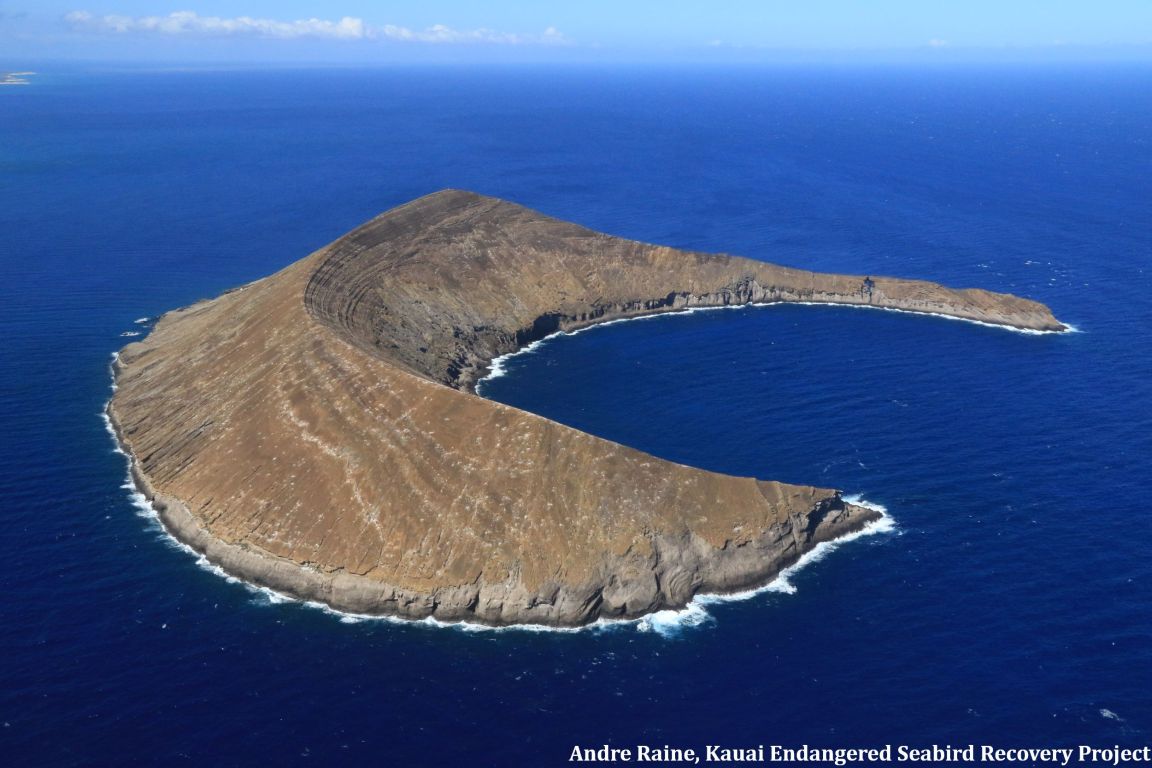The Kauaʻi Endangered Seabird Recovery Project undertakes research projects throughout the island of Kauaʻi and within the wider Hawaiian Islands. This includes some of the most remote and beautiful locations within Kauaʻi. A selection of our main study sites are included below.
Upper Limahuli Preserve
The Upper Limahuli Preserve is a 400 acre preserve managed by the National Tropical Botanical Garden (NTBG). Encompassing the land above Limahuli Falls and the Lower Limahuli Preserve, this remote area reaches its highest elevation at 3,330 feet and can only be accessed by helicopter. The site contains important breeding populations of both Hawaiian Petrel and Newell’s Shearwater. KESRP has been working in the preserve since 2006, predominantly to monitor known breeding burrows of both Newell’s Shearwaters and Hawaiian Petrels, map breeding distribution, and provide advice on management actions pertaining to the survival of endangered seabirds within the preserve. For more information about Upper Limahuli Preserve and NTBG’s work in Kauaʻi, have a look at their website: http://www.ntbg.org.

Kīlauea Point National Wildlife Refuge
Kīlauea Point National Wildlife Refuge encompasses 203 acres on the north-east coast of Kauaʻi, two miles north of the town of Kīlauea. The refuge habitat is a coastal complex of steep cliffs abutting the ocean, buildings and small lawns surrounded by dense Beach Naupaka (Scaevola sericea) and Screw Pine (Pandanus tectorius) thickets and a few patches of Common Ironwood (Casuarina equisetifolia) and Coconut (Cocos nucifera). The site is an important breeding area for a number of seabird species including Laysan Albatross (Phoebastria immutabilis), Wedge-tailed Shearwater (Puffinus pacificus), Red-tailed Tropicbird (Phaethon rubricauda) and Red-footed Booby (Sula sula) and also holds a large breeding population of the endangered Nēnē (Branta sandvicensis). The site also holds the only known coastal breeding population of Newell’s Shearwater and is the site of a Social Attraction Project for this species jointly run by KESRP and KPNWR. For more information about Kīlauea Point and the National Wildlife Refuge system, have a look at their website: http://www.fws.gov/kilaueapoint/
Hono O Nā Pali Natural Area Reserve
This incredibly picturesque reserve occupies 3,578.8 acres in the north of Kauaʻi. Stretching all the way from sea level up to the peak of Pihea (at 4,284 feet), the reserve encompasses 11 different biological communities as varied as mixed montane bog, coastal mesic forest, and montane wet forest. It is in the upper reaches of the reserve that KESRP have identified breeding colonies of both Hawaiian Petrel and Newell’s Shearwater, often nesting in high densities. The remote location, dense natural habitat and distance from human habitation (and light sources) combine to make this one of the most important areas for endangered seabirds remaining in Kauaʻi. KESRP carries out survey trips to Hono O Nā Pali NAR to map seabird breeding distribution, monitor known breeding burrows of both shearwaters and petrels, and provide advice on management actions pertaining to the survival of endangered seabirds within the reserve.

Lehua Islet
This 284 acre islet sits 31 km due west of Kauaʻi and is only 1.2 km north of the island of Niʻihau. It is a sparsely vegetated, crescent-shaped islet that is actually part of the Niʻihau volcano. Because there are no human inhabitants on the islet, it is a haven for seabirds with an estimated 25,000 pairs of at least eight seabirds breeding on Lehua. These include both Laysan and Black-footed (Phoebastria nigripes) Albatrosses, Red-footed and Brown (Sula leucogaster) boobies, Wedge-tailed Shearwater, Bulwer’s Petrel (Bulweria bulwerii) and Red-tailed Tropicbird (Phaethon rubricauda) . The islet’s sea caves also hold breeding colonies of Hawaiian Black Noddy (Anous minutus melanogenys). Surveys on Lehua have produced evidence that the islet may also hold small breeding populations of Newell’s Shearwater and Band-rumped Storm-Petrel. KESRP conducts seabird survey and monitoring trips to the islet, with a particular emphasis on trying to locate breeding populations of Newell’s Shearwaters and Band-rumped Storm-Petrels.

